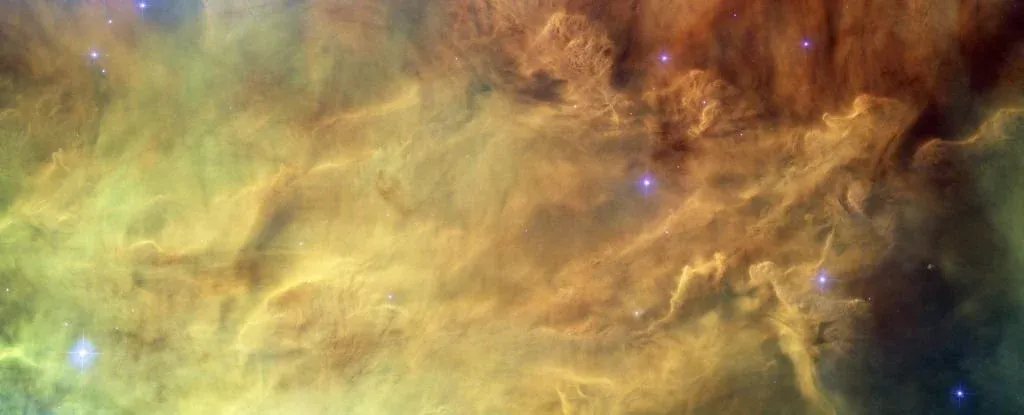
The ancient primordial helium that was forged in the wake of the Big Bang is escaping from the Earth's core, scientists report in a new study.
But rest assured, there is no cause for alarm, experts say, the Earth is not deflating, but this discovery is the confirmation of a hitherto unresolved detail about the birth of our planet: Earth formed inside a solar nebula, the same molecular cloud that gave rise to the Sun.
Another thing this study suggests is that other primordial gases may be leaking from the Earth's core into the mantle, which in turn could provide information about the composition of the solar nebula.
Helium on Earth comes in two stable isotopes. By far the most common is helium-4, whose nucleus contains two protons and two neutrons. Helium-4 accounts for about 99.99986% of all helium on our planet.
The other stable isotope, which accounts for approximately 0.000137% of Earth's helium, is helium-3, with two protons and one neutron.
Helium-4 is primarily the product of the radioactive decay of uranium and thorium, which occurs right here on Earth. On the contrary, Helium-3 is primarily primordial, formed in the moments after the Big Bang, but it can also be produced by the radioactive decay of tritium.
This is the gas detected escaping the Earth's core, the isotope Helium-3, which is leaking mainly along the system of volcanic ridges in the middle of the ocean, which gives us a good indication of the speed at which it escapes from the crust.
That rate is about 2,000 grams a year: “enough to fill a balloon the size of a desk,” explains geophysicist Peter Olson of the University of New Mexico.
“It's a wonder of nature, and a clue to Earth's history, that there is still a significant amount of this isotope inside the Earth,” he adds.
What is less clear is the source; how much of the helium-3 could be emerging from the nucleus, compared to how much is in the mantle.
This would tell us the source of the isotope. When Earth formed, it did so by collecting material from the dust and gas that floated around the newborn Sun.
The only way that significant amounts of helium-3 could be inside the planetary nucleus is if it formed in a thriving nebula. That means, not on the outskirts, and not as it dissipated and flew.
Olson and his colleague, geochemist Zachary Sharp from the University of New Mexico, investigated modeling the Earth's helium inventory as it evolved. First, how it was formed, a process during which the protoplanet accumulated and incorporated helium; and then after the Great Impact.
This, astronomers think, happened when an object the size of Mars hit a very young Earth, sending debris flying into Earth's orbit, which eventually recombined to form the Moon.
During this event, which would have remelted the mantle, much of the helium enclosed within the mantle would have been lost. The core, however, is more resistant to impact, suggesting that it could be a fairly effective reservoir for retaining helium-3.

In fact, this is what the researchers found. Using the current rate at which helium-3 is escaping from the interior, as well as models of the behavior of helium isotopes, Olson and Sharp found that there are probably 10 teragrams (10 billion grams) per petagram (100 million tons) of helium-3 in the core of our planet.
This suggests that the planet must have formed within a prosperous solar nebula and that it did not “join” the solar system after its formation. However, several uncertainties remain. The probability that all conditions for the sequestration of helium-3 will be met in the Earth's core is moderately low, which means that there may be less isotope than the team's work suggests.
However, it is possible that there is also abundant primordial hydrogen in the core of our planet, trapped in the same process that may have accumulated helium-3. Looking for evidence of hydrogen leakage could help validate the findings, the researchers say.
KEEP READING
Últimas Noticias
Debanhi Escobar: they secured the motel where she was found lifeless in a cistern
Members of the Specialized Prosecutor's Office in Nuevo León secured the Nueva Castilla Motel as part of the investigations into the case

The oldest person in the world died at the age of 119
Kane Tanaka lived in Japan. She was born six months earlier than George Orwell, the same year that the Wright brothers first flew, and Marie Curie became the first woman to win a Nobel Prize

Macabre find in CDMX: they left a body bagged and tied in a taxi
The body was left in the back seats of the car. It was covered with black bags and tied with industrial tape
The eagles of America will face Manchester City in a duel of legends. Here are the details
The top Mexican football champion will play a match with Pep Guardiola's squad in the Lone Star Cup

Why is it good to bring dogs out to know the world when they are puppies
A so-called protection against the spread of diseases threatens the integral development of dogs




